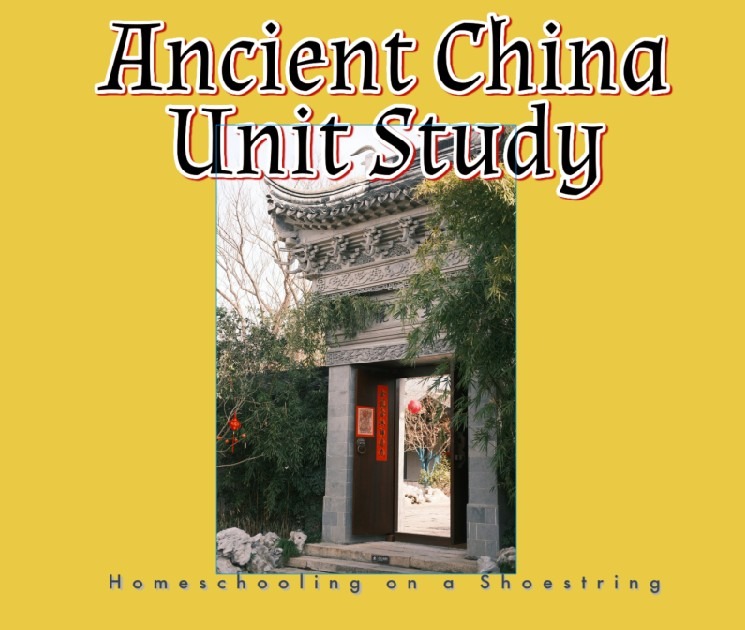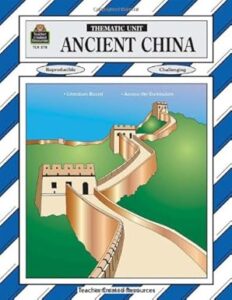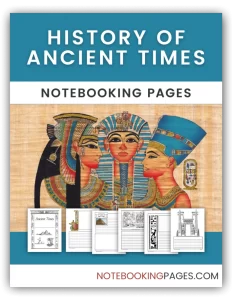
Ancient China Unit Study
The unit is suitable for grades K–12, with flexibility to adapt based on your learners’ ages and abilities. Please preview links and activities to ensure they are appropriate for your family. New resources will be added as time allows.
Many of the links below lead to printable resources that can be added to a notebook or lapbook for this study.
Learning Objectives
Many parents and teachers will need to create their own goals. You can compare the goals at these sites to create your own goals depending on how stringent your requirements need to be. All links have several suggested activities for different ages.
Suggested Curriculum Standards:
- World Book Scope Basic Course structure https://www.worldbook.com/free-educational-resources#tcos
- Michigan Department of Education https://www.michigan.gov/mde/services/academic-standards
- Maine as an example of state level requirements https://www.maine.gov/doe/ela/standards/index.html
- California state level requirements https://www.cde.ca.gov/be/st/ss/
- McREL Compendium National Level https://www2.mcrel.org/compendium/
- Ontario Canada K-8 Expectations https://www.dcp.edu.gov.on.ca/en/curriculum#elementary
- Abeka Scope and Sequence https://www.abeka.com/HomeSchool/ScopeAndSequence.aspx
- The series of books called “What your nth Grader needs to know” May also be helpful nth representing the grade your child is in. This series only Goes to grade 8
By the end of this unit, students will be able to:
- Identify major dynasties, inventions, and historical figures of Ancient China
- Describe the core beliefs of Confucianism, Taoism, and Buddhism
- Locate key geographical features of China
- Explore Chinese writing, art, and traditional stories
- Compare Ancient Chinese beliefs with those of other cultures and religions
Bible References
Look up and compare scriptures at the sites below. In your journal, note how reading different translations and versions can deepen your understanding of each passage.
Bible Tools:
- American Standard Version https://ebible.org/asv/
- King James Bible in Mp3 https://www.audiotreasure.com/indexKJV.htm
- World English Bible in Mp3 https://www.audiotreasure.com/webindex.htm
- World Wide Study Bible https://www.ccel.org/wwsb
- E-Sword Bible Software. Free software that will allow you to compare many translations at the same time https://www.e-sword.net/
- New World Translation https://www.jw.org/en/library/bible/study-bible/books/
General Comparative Religion Resources
While this unit includes Bible resources in alignment with Unit-Safari’s original group foundation, it also features sacred texts and resources from other world belief systems relevant to the culture or time period being studied. For broader interfaith or comparative study, you may wish to explore the following multifaith resources:
- Sacred Texts Archive – Multifaith digital library
- World Scripture: A Comparative Anthology
- Harvard Pluralism Project – Interfaith literacy resources
- BBC Religions – Beliefs, texts, and practices from major world religions
Chinese Sacred & Philosophical Texts
Ancient China was shaped by a rich blend of philosophical and religious traditions. The most prominent include Confucianism, Taoism (Daoism), and Buddhism. These systems often emphasized personal virtue, harmony, and social responsibility. Students may compare these texts and beliefs with sacred writings from other world religions.
- Tao Te Ching (Laozi) – Full English translation
- Analects of Confucius – Project Gutenberg
- The Dhammapada (Buddhist Teachings)
- Zhuangzi (Chuang Tzu) – Daoist parables and stories
- Diamond Sutra – Mahayana Buddhist scripture
Discussion & Activity Prompt:
Select one quote from a Chinese belief system—such as Taoism, Confucianism, or Buddhism—and one from another world religion or your own tradition. Write a short reflection or discuss how each quote reflects the culture and values of its time. What moral teachings or worldviews do they share?
Timeline
Create a fold-out accordion timeline in their notebook or use printable timeline figures to paste along a wall-length timeline in your homeschool area.
Suggested individuals and events to include in your timeline:
- Confucius – A wise teacher whose ideas helped shape how people in China lived and treated one another.
- Laozi (Lao Tzu) – An important thinker who started Taoism and wrote a book called the Tao Te Ching.
- Qin Shi Huang – The first emperor to unite China; he had the Terracotta Warriors built to guard his tomb.
- Emperor Wu of Han – A powerful leader who helped China grow and share ideas and inventions with other places.
- Invention of paper – Invented during the Han Dynasty around 105 CE, this changed how people shared and saved information.
- Invention of gunpowder – Created during the Tang Dynasty in the 800s; it was later used in fireworks and weapons.
- Zheng He – A famous sailor who led long sea trips to other countries during the Ming Dynasty.
- Silk Road trade – A network of roads used for trading silk, spices, and ideas between China and other parts of the world.
- Great Wall of China – A long wall built and added to over many years to protect China’s northern border.
- Buddhism in China – This belief system from India began to spread into China around the 1st–2nd century CE.
- Printing with movable type – Invented during the Song Dynasty, it made it easier to make books and share knowledge.
- Mulan (legend) – A story about a brave young woman who takes her father’s place in the army.
- Marco Polo – A traveler from Italy who visited China and told stories about what he saw there.
- Genghis Khan – A powerful Mongol leader who once ruled over China and much of Asia.
Additional Timeline Context
To help frame the major people and inventions above, you may also want to add key dynasties and achievements to your timeline:
Key Dynasties:
- Xia Dynasty (2070–1600 BCE) – Considered the first dynasty in traditional Chinese history.
- Shang Dynasty (1600–1046 BCE) – Known for bronze work, early writing, and oracle bones.
- Zhou Dynasty (1046–256 BCE) – Introduced the Mandate of Heaven and saw early philosophies emerge.
- Qin Dynasty (221–206 BCE) – Unified China under one emperor and started the Great Wall.
- Han Dynasty (206 BCE–220 CE) – Expanded trade, government, and technology like paper-making.
Major Achievements:
- The Great Wall of China – Defensive wall built and expanded under several dynasties.
- The Terracotta Army – Thousands of life-sized clay soldiers buried with Emperor Qin Shi Huang.
- Four Great Inventions of Ancient China:
- Compass
- Gunpowder
- Papermaking
- Printing
Timeline Resources:
- TimeMaps of World History – Timeline by Region
- University of Maryland: Chinese Historical Timeline
- World History Encyclopedia timeline Ancient China
Vocabulary
These vocabulary words can be used for spelling, copywork, notebooking, vocabulary journals, lapbooks, or as prompts for creative writing and research.
Geography & Regions:
China Sea
Himalayan Mountains
Hong Kong
Hwang Ho River (Yellow River)
India
Korea
Mongolia
Mt. Everest
Taiwan
Yangtze River
Yellow Sea
Culture & Belief Systems:
abacus
Buddhism
Confucius
dynasty
karate
lacquer
pagoda
rickshaw
sampan
Taijiquan
Taoism
Inventions & Science:
acupuncture
cast iron plow
collar (horse collar)
compass
gunpowder
invention
matches
movable type
paper
printing
seismograph
silkworm
spinning wheel
tea
umbrella
water clock
wheelbarrow
Animals & Nature:
bamboo
chrysanthemum
endangered
panda
Technology Tip:
WordWeb Dictionary – Free downloadable dictionary software
Dictionary.com – Online definitions and pronunciation
Book Resources
(Note: These titles are linked to Amazon using my affiliate ID. If you make a purchase through these links, it helps support the site at no extra cost to you.)
Nonfiction
- Ancient China by Hazel Martell
- Ancient China by Judith Simpson
- Ancient China by Robert Knox
- Ancient Chinese Dynasties by Eleanor J. Hall
- China by Marcia Fries
- China: The Land and Its People by Jonathan Hammond
- Cooking the Chinese Way by Ling Yu
- Growing Up in Ancient China by Ken Teague
- Kublai Khan by Kim Dramer
- Silkworms by Sylvia Johnson
- The Ancient Chinese by Julia Waterlow
- The Ancient Chinese: Look Into the Past by Julia Waterlow
- Ancient China’s Inventions, Technology and Engineering by Professor Beaver
- Ancient Chinese Inventions That Changed the World by Barbara Hall
Picture Books & Legends
- Yeh-Shen: A Cinderella Story from China by Ai-Ling Louie
- Chin Chiang and the Dragon’s Dance by Ian Wallace
- The Empty Pot by Demi
- The Emperor and the Kite by Jane Yolen
- Ming Lo Moves the Mountain by Arnold Lobel
- The Seven Chinese Brothers by Margaret Mahy
- Moon Lady by Amy Tan
- Lon Po Po by Ed Young
- How the Ox Star Fell from Heaven by Lily Toy Hong
- Mei Li by Thomas Handforth
- Zheng He, the Great Chinese Explorer: A Bilingual Story by Li Jian
- Chinese Legends For Kids by History Brought Alive
Historical Fiction
- A Grain of Rice by Helena Clare Pittman
- Lady of Ch‘iao Kuo: Warrior of the South by Laurence Yep
- Dragonkeeper by Carole Wilkinson
Curriculum & Activity Books
- China Then and Now by Susan Finney
- China: A Literature-Based Multicultural Unit by Betsy Franco
- International Spring and Summer Festivals by Marilynn G. Barr
- Patterns for World Cultures by Marilynn G. Barr
- A Coloring Book of Ancient China by Bellerophon Books
- Ancient China Coloring Book: History Chinese and China Architecture Coloring Pages
Bonus & Noteworthy Titles
This includes poetry, cross-cultural reads, unique formats (like cookbooks or art books), and anything that didn’t fit neatly into the earlier categories but still brings value to the unit.
- Dragon Kites and Dragonflies by J.H. Plumb
- Everyone Knows What a Dragon Looks Like by Jay Williams
- The Great Wall of China by Leonard Everett Fisher
- The Magic Paintbrush by Laurence Yep
- Chinese Proverbs: The Wisdom of Cheng-Yu by James Trapp
- Ancient Chinese Proverbs for Kids by Global Kidz House
- The Chinese Siamese Cat by Amy Tan – Sagwa, my family’s personal favorite!
Poetry + Music
Explore ancient Chinese poetry and music to connect with the values, rhythms, and imagery of the time.
Streaming Music
- Ancient Chinese Music Compilation – Instrumental and cultural tracks.
- “Ancient China” by Mr. Nicky – Educational history rap.
Video & Software Resources
Enhance your study of Ancient China with engaging media. These videos, podcasts, and games provide visual and auditory context to dynasties, inventions, daily life, and legends.
Educational Videos & Podcasts
- National Geographic: Ancient China – YouTube search results include kid-friendly explainers and documentaries.
- YouTube: Ancient China Documentaries for Kids – Curated for younger learners.
- The History of China Podcast – Deep dives into dynasties, rulers, and culture. Also available on Spotify.
Streaming or Library Use
- Mulan – Use both animated and live-action versions for compare/contrast activities.
- Ancient China Unearthed – Documentary series exploring archaeological finds (BBC/National Geographic).
- The Emperor’s Ghost Army – Focuses on the Terracotta Warriors (PBS or National Geographic).
Games
Use these ideas to turn key concepts from this unit into creative, engaging games your learners will love.
Game Board Blanks
Create your own themed games for this unit using printable templates and inspiration from the sites below:
- Games . . . Tools for Learning by Mark and Janice Vreeland
- Games for Learning ideas from Mary Peterson
- Board Game Templates – Tim’s Printables – free blank game boards
- JustFamilyFun – Board Game Paths
- Educational Board Games – Cardboard Cognition – printable game boards and pieces
More Game Ideas
Games can help reinforce cultural understanding and physical geography in a fun and interactive way. These traditional games and activities are great for groups or co-op settings.
- Tsoo Tsoo (Hen and Chickens Game): Blindfold one player (the “hen”) who tries to tag the other players (“chickens”) as they run in a circle. The first tagged player becomes the next hen.
- Dragon Tag: Players line up and link arms around the waist of the person in front. The “dragon’s head” (front of the line) tries to catch the “tail” (back of the line) without breaking the chain.
- Spillikins (Pick-up Sticks): A traditional game of dexterity using thin sticks. You can explore its Chinese origins at Wikipedia: Spillikins.
GeoSafari Cards
Using the GeoSafari Instruction Guide, you can create a wide variety of custom cards for this unit. GeoSafari is especially great for independent learning and long car trips!
Donna Young shows you how to make GeoSafari Cards
DIY Card Ideas
- Timeline event ↔ date matching cards
- True or false review questions
- Vocabulary words ↔ real-life images
- Chapter-based quizzes or review sets
Use these ideas to create trivia cards, quiz games, or interactive review tools based on Ancient China. Great for laminated decks, co-op centers, or DIY board games.
Categories You Might Include:
- Dynasties & Leaders: Han, Qin, Tang, Song, Ming, Emperor Wu, Qin Shi Huang
- Inventions: Kite, compass, gunpowder, paper, movable type, wheelbarrow
- Geography: Yangtze River, Yellow River, Silk Road, Great Wall, Himalayan Mountains
- Belief Systems: Confucianism, Taoism, Buddhism – core ideas or symbols
- Famous People: Confucius, Laozi, Zheng He, Mulan (legend), Marco Polo (visitor)
- Festivals: Lantern Festival, Dragon Boat Festival, Mid-Autumn Festival
Example Prompts:
- “Which Chinese invention helped sailors navigate at sea?” (Compass)
- “Name the structure built to protect China’s northern border.” (Great Wall of China)
- “Which dynasty is known for the Terracotta Army?” (Qin Dynasty)
- “What was the purpose of the Silk Road?” (Trade between China and the West)
Clip Art
Enhance your games, GeoSafari cards, notebooking pages, lapbooks, reports, and presentations with themed clip art and printables inspired by Ancient China. These visual resources are especially useful for younger students and visual learners.
- Classroom Clipart: Ancient China – A variety of illustrations including people, architecture, and daily life scenes.
- Phillip Martin Clip Art: China Collection – Bright, kid-friendly artwork ideal for elementary use.
Art and Craft Ideas
Engage with Ancient China through simple, hands-on projects that highlight traditional art, cultural symbols, and historical elements. These activities are suitable for a range of ages and can support notebooking, lapbooks, or thematic studies.
- Chinese Paper Cutting – Learn about traditional symbols and design your own paper cuts.
- 3D Papercraft: Forbidden City
- Temple of Heaven Papercraft
- Great Wall of China Papercraft
- Giant Panda Papercraft
- Chinese Calligraphy Introductions – Overview from Kahn Academy.
- Chinese Parade Dragon – (French site) Create a paper dragon for decoration or pretend play.
YouTube & Articles:
- Appreciating Chinese Calligraphy
- The Eight Basic Chinese Strokes
- Cultural Overview of Papercuts
- Alice Chinese Papercutting YouTube Channel
Hands-On Suggestions:
- Salt Dough Great Wall: Mold bricks from dough, assemble, and paint.
- Sugar Cube Wall: Use icing to build a miniature Great Wall.
- Map Cookies: Shape China’s outline and decorate with edible geography.
- Make Paper: Create homemade paper to understand this important Chinese invention
- Clay Warriors: Craft mini terracotta warriors using modeling clay
Recipes
Introduce learners to Ancient Chinese cuisine with a simple, approachable recipe using familiar ingredients. Cooking can spark discussion about geography, trade, customs, and daily life. Try this Egg Drop Soup Recipe from The Woks of Life.
Hands-On Suggestions – These activities can support lessons in measurement, kitchen skills, and cultural awareness.
- Make a basic stir-fry, fried rice, or noodle dish using ingredients on hand.
- Create your own fortune cookies and include cultural sayings or proverbs inside.
- Try folding dumplings using pre-made wrappers and simple fillings.
- Use chopsticks to pick up small foods like marshmallows, grapes, or crackers.
Field Trips
Bring Ancient China to life with in-person or virtual experiences. These outings and resources can deepen understanding of Chinese history, inventions, and cultural legacy. Create a scavenger hunt for things to spot (dragons, calligraphy, silk, etc.) or have students reflect on what they learned in a journal or drawing.
In-Person Ideas:
- Art Museums: Look for collections featuring Chinese pottery, scrolls, jade, calligraphy, or Terracotta Warrior replicas.
- History Museums: Some have rotating exhibits on the Silk Road, Chinese dynasties, or early civilizations.
- Chinese Cultural Centers or Festivals: Attend Lunar New Year events, tea ceremonies, or martial arts demonstrations.
- Botanical Gardens: Explore sections dedicated to Asian landscaping or bamboo groves.
- Restaurants or Markets: Visit an Asian market or eat at a Chinese restaurant. Observe menus, try new dishes, and look for calligraphy or decor to discuss.
Virtual Field Trips:
- Walk the Great Wall of China
- Virtual Tour: Terracotta Warriors
- The Met: Qing Dynasty Artifacts
- Google Arts & Culture: Ancient China Collection
- Smithsonian Learning Lab: Terracotta Army
Activities and Lesson Plans
Explore Ancient China through creative, cross-curricular projects. These activities are adaptable across grade levels and work well for homeschool families or co-ops.
Project Ideas:
- Create a mini-book, lapbook, or timeline showcasing key topics in Ancient China.
- Make a Venn diagram comparing the legend of Mulan across the poem, Wikipedia entry, and Disney film.
- Write your name in Chinese calligraphy.
- Research a Chinese invention (e.g., paper, seismograph, compass) and create a display or mini-presentation.
- Design a model habitat or fact sheet about pandas or other endangered Chinese animals.
- Compare religions: Buddhism, Taoism, Confucianism — chart values, practices, and symbols.
Suggested Research Topics – Use as journal prompts or mini-essay starters:
- Festival of Pure Brightness
- Dragon Boat Festival
- Mid-Autumn Festival (Moon Festival)
- Lantern Festival
- Chrysanthemum Festival
- Genghis Khan or Kublai Khan
- Silkworms and the Silk Road
- Terraced rice farming
- Chinese innovations: kite, movable type, paper, compass, etc.
Lesson Plans:
- Core Knowledge: Dynasties of China – Also see the Teacher Guide and Student Guide
- A to Z Kids Stuff: China – Simple activities for younger learners.
- Crystal Links: Ancient China – Timeline, beliefs, daily life, inventions.
Worksheets
Make your own worksheets with these worksheet creation tools:
- SchoolHouseTech https://www.schoolhousetech.com/ This company gives away two free software worksheet factories one for Basic math and one for wordsearch utility that will make wonderful complements to this unit when you include the clipart listed in the clipart section.
- Start Write – This program makes nice reports and handwriting worksheets for the unit. https://www.startwrite.com/
- TeachNology has several online worksheet makers and a ton of Rubric makers. Rubrics work great with Homeschool Tracker because they give you total points and you count up exactly how many points your child gets. https://www.teach-nology.com/worksheets/
- Online Crossword Puzzle Maker to use with your vocabulary words or locations or even dates from the timeline. https://www.happychild.org.uk/wks/english/ssm/crosswords01.htm
Project Gutenberg Historical Texts – Use public domain texts to create your own worksheets or discussion guides.
- Gutenberg China Collection – Historical texts for reading, vocabulary work, or comprehension questions.
Information & General Resources
These reference sites offer historical overviews, maps, cultural insights, and educational content to support your study of Ancient China. They can be used as background reading for reports, notebooking pages, comparison charts for inventions or dynasties, or to deepen student discussions.
- University of Maryland: Chinese History – Timelines, summaries, and resources organized by dynasty and era.
- World History Encyclopedia: China – Student-friendly articles on Chinese history, innovations, and culture.
- PBS NOVA: Mummies of Urumchi – Archaeological insights into early peoples in western China.
Web Information
Explore Ancient China through these active and archived online resources. You’ll find lesson plans, student guides, research tools, and visual content to support your studies.
- KidsKonnect: Ancient China – Overview articles and printable worksheets.
- History for Kids: China – Articles on dynasties, inventions, daily life, and religion.
- Splendors of Imperial China: Asian Art – Exhibition view from the National Palace Museum, Taipei, hosted by The Metropolitan Museum of Art.
- National Geographic: China Search – Use the search bar with terms like “Ancient China” to find videos, articles, and teaching materials.
- Mr. Donn: Ancient China – Longtime favorite for printable lessons, PowerPoints, and unit study ideas.
- Ducksters: Ancient China Daily Life – Short articles tailored to upper elementary and middle school learners.
- British Museum: China’s Hidden Century – Exhibit resources and digital collection for deeper exploration.
Ancient China Lapbook Ideas
These lapbook suggestions work alongside notebooking, timelines, and hands-on projects. Each component encourages students to summarize, visualize, and creatively explore Ancient China.
- Vocabulary Flip Book: Sort terms by Geography, Inventions, Culture & Religion, and Nature.
- Invention Mini-books: Feature key innovations like paper, movable type, the seismograph, kite, or compass with illustrations and use summaries.
- Poetry Timeline: Create minit books with poet bios, a sample poem, and visual imagery. Use a scroll or accordion fold-out format.
- Poetry Explorations: Include styles like couplets or Tang-style poems. Students can write their own and illustrate them inside a foldable scroll.
- Calligraphy Display: Students write their name or characters from the unit using brush pens or calligraphy markers.
- Religion Mini-books: Use flaps or comparison charts to explore Taoism, Buddhism, and Confucianism (beliefs, values, symbols).
- Fables & Legends: Retell Yeh-Shen, Mulan, or other traditional stories with comic strip panels or foldable scenes.
- Great Wall Craft Booklet: Add a fact flap on construction, purpose, and dynasties involved. Use coloring pages or photos.
- Silk & Trade Book: Create a map of the Silk Road, then lift-the-flap facts on goods, routes, and cultural exchange.
- Festival Facts: Make minit books for the Lantern Festival, Dragon Boat Festival, Mid-Autumn Festival, and others.
- Cooking Activity Reflection: Add a “My Food Experience” foldable for recipes tried during the unit (with illustrations or short reviews).
Evaluation Ideas
Assemble a three ring binder and please include:
- A copy of this unit
- Course Description (Highschool Students)
- Write a summary about books read for the unit
- Write an essay on the various topics discussed
- Your Lapbook created for the unit (K-8 Students)
- Any worksheets or activity books created with SchoolhouseTech Software https://www.schoolhousetech.com/
- Your journal and its contents
- Your Log of activities from Homeschool Tracker https://www.homeschooltracker.com/free-homeschool-tracker-basic-edition Its Free!
- Your Timeline
This updated Ancient China Unit Study was originally compiled on October 1, 1999, with revisits on February 2003 and July 2007. It has since been fully reworked with updated resources, fresh activities, revised vocabulary, and expanded content for 2025. Numerous dead links have been removed or replaced, making this version more reliable and accessible for today’s homeschoolers.
![]()
Affiliate Links
| Amazon | NotebookingPages.com |
|---|---|
 |
 |

3 Comments
Linda Reed Friedman
Wow – I agree with Doug- That is a lot of material. A lot of work. Thank you for doing that since I know there is a teacher looking for exactly what you wrote.
Doug
Wow. This is very comprehensive. I can see why it covers K-12. Those sources could provide university level information too.
Blog on!
Vidya
wow! this is a comprehensive themed study plan. I am going to check out the rest as well and bookmark your blog..